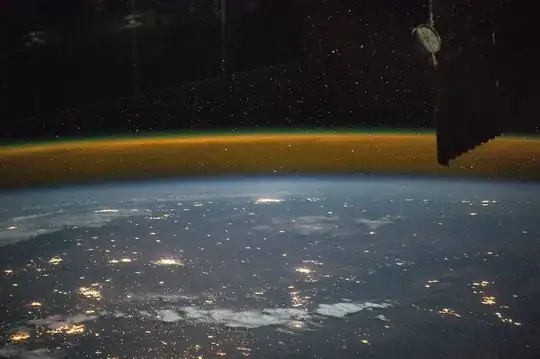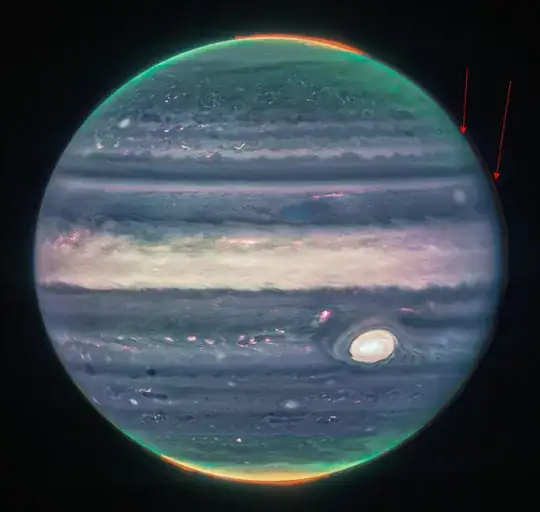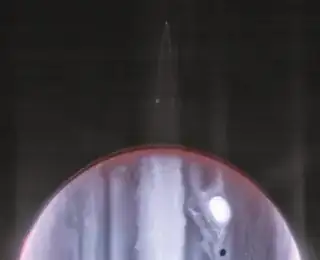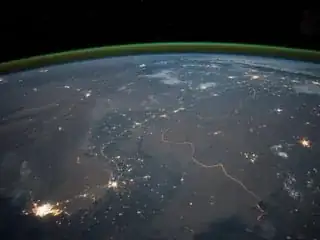Then new JWST image of Jupiter shows a small halo on the right side of the planet. What's causing this feature? I figure it could be that the planet is simply overexposed (or moving slightly during the exposure?). Or perhaps this is a phase effect, and the boundary between the light and dark limbs corresponds to the jovian terminator?
-
2This might be totally wrong, but it’s possible that in image processing this was combined with images taken at sufficiently separated times or long enough exposures that the movement of Jupiter mattered in how everything averages out, which would be in agreement with the opposite side not having the same halo. This image shows the same effect more dramatically – Justin T Aug 26 '22 at 04:20
-
2That's a great hypothesis, but I'd expect such a shift to be just a translation (no atmosphere in space) to be pretty easy to correct. Of course, it could be that Jupiter's rotation has blurred out the features between exposures (amateur astronomers use tools like WinJupos to de-rotate their images) - but the atmospheric bands look exceptionally clear (except of course for the right limb). Also, if it were just a translation error, wouldn't we expect a boundary just on the 'inside' of the limb on the left side? – user2944352 Aug 26 '22 at 06:42
-
2@user2944532 You make some excellent points, and you’re probably right. As far as the boundary on the left side, the image I linked has a bit of a boundary it seems on the left side which is what made me think of it. – Justin T Aug 26 '22 at 14:59
-
2My bet is on atmospheric refraction. Notice it's only visible on the dark side. The dark part is where the atmosphere is too opaque to transmit the light. Like what you see here: https://www.space.com/3747-eclipse-moon-probe-earth-blocks-sun.html – Greg Miller Aug 26 '22 at 20:40
-
That's another interesting idea. It's clear to me how in the image you linked atmospheric refraction makes sense. However, in that case, the planet is between the observer (Kaguya) and the light source (the sun). The geometry in the JWST image is very different, with the observer being between the planet and the light source. It's hard for me to imagine how refraction could make sense in this case. Could you elaborate further? – user2944352 Aug 27 '22 at 07:27
-
2It covers the whole right hemisphere from north to south pole with the same thickness. That IMO rules out the translation hypothesis. And: Do we know the wavelengths shown in this picture? if it's in the far IR it could be some thermal radiation generated somewhere in the upper atmosphere. – asdfex Aug 27 '22 at 18:29
-
Thanks @asdfex, I think this sounds plausible. Looks like red hues in this image were taken with the F360M which is centered about 3.6 microns, so thermal emission might make sense (especially if that line is the Jovian terminator, the gas beyond that boundary should be cooler). – user2944352 Aug 28 '22 at 02:18
1 Answers
This seems to be airglow.
At least Scott Sutherland claimed this in the June 15, 2022 Weather Network article Webb bonus: Jupiter's clouds, moons, and ring shine bright in new images, and Dr James O'Donoghue gave a nice explanation on Twitter. Apparently we only see this on the right side, as it is slightly in the shadow.
click images for full size:
This is incredible. What we might be seeing here is the glow of Jupiter's upper atmosphere, but separated from the planet itself! What a shot, Great Red Spot, rings, moons, moon shadow and airglow like we see on Earth! Quote Tweet
And it fits the detection in UV wavelengths.
Compare this to the same phenomenon on earth and it seems plausible. Earths airglow is also detectable in the near-IR. The JWST image was taken with the NIRCam instrument 2.12 micron filter.

-
Great answer, thanks! If you are uncomfortable with the edit please feel free to roll back or edit further. – uhoh Sep 26 '22 at 19:05
-
1
-


